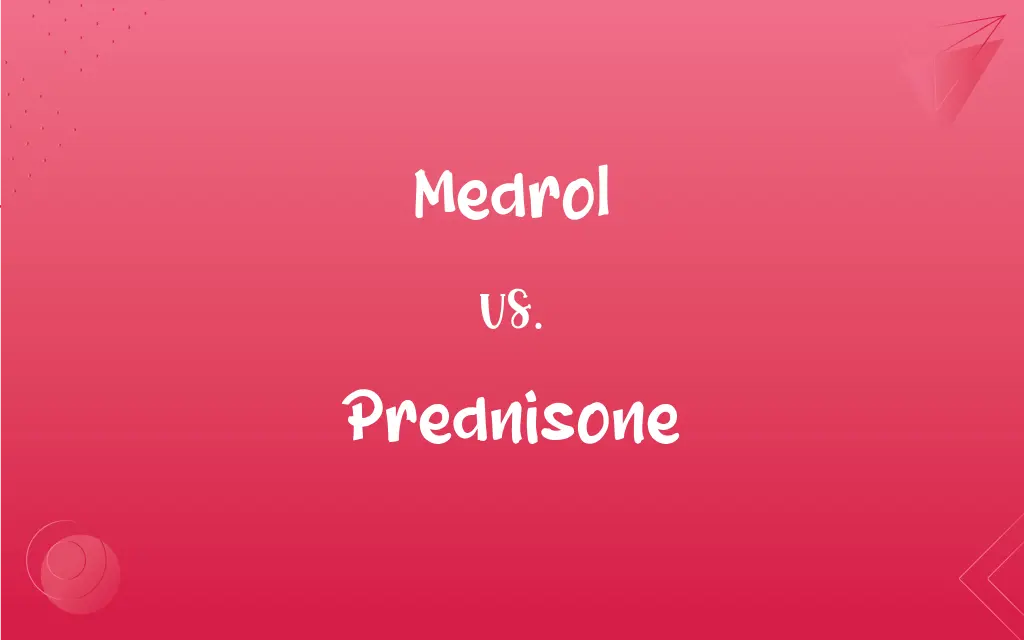Medrol vs. Prednisone: What's the Difference?
Edited by Aimie Carlson || By Harlon Moss || Updated on October 16, 2023
Medrol and prednisone are both corticosteroids, but Medrol (methylprednisolone) has a slightly higher potency than prednisone.

Key Differences
Medrol, known generically as methylprednisolone, is a synthetic corticosteroid with anti-inflammatory effects. Prednisone, another corticosteroid, also suppresses the immune system and inflammation. Both are used to treat a range of inflammatory and autoimmune conditions.
Medrol has a slightly higher relative potency compared to prednisone, which means lower dosages of Medrol may achieve the same anti-inflammatory effects as higher doses of prednisone. Both drugs, however, can effectively reduce inflammation and overactivity in the immune system.
Medrol is usually prescribed in cases requiring immediate relief due to its shorter onset of action, whereas prednisone may be prescribed for longer-term treatment. Both medications, though, need to be tapered off gradually to avoid withdrawal symptoms.
The side effects of Medrol and prednisone are similar, given their similar pharmacological profiles. Both can cause increased blood sugar, insomnia, mood changes, and weight gain, among others.
While both Medrol and prednisone can be life-saving, they suppress the immune system, potentially making patients more susceptible to infections. Long-term use of both medications is closely monitored due to potential adverse effects.
ADVERTISEMENT
Comparison Chart
Generic Name
Methylprednisolone
Prednisone
Relative Potency
Slightly higher
Slightly lower
Onset of Action
Shorter, quicker effect
Longer, more sustained effect
Dosage Variability
Lower doses for similar effects
Higher doses needed
Side Effects
Insomnia, mood changes, etc.
Similar to Medrol
ADVERTISEMENT
Medrol and Prednisone Definitions
Medrol
Medrol, known generically as methylprednisolone, has a range of applications, including autoimmune diseases, allergic reactions, and certain cancers.
Medrol was effective in reducing the patient's allergic reaction symptoms rapidly.
Prednisone
Prednisone is commonly used to treat autoimmune diseases, allergies, and asthma due to its anti-inflammatory properties.
He was given prednisone to manage his severe allergic reaction to bee stings.
Medrol
Medrol operates by inhibiting the immune response, often utilized in autoimmune disorders.
Because of its immune-suppressing properties, Medrol was the chosen treatment for rheumatoid arthritis.
Prednisone
Prednisone is a synthetic corticosteroid used to treat inflammatory diseases and suppress the immune system.
Prednisone was prescribed to reduce inflammation in the patient with Crohn's disease.
Medrol
Medrol requires cautious tapering to prevent withdrawal, due to its potent effects on adrenal gland function.
The gradual tapering schedule of Medrol helped the patient avoid adrenal insufficiency.
Prednisone
Prednisone mimics the anti-inflammatory action of natural corticosteroids produced by the adrenal glands.
Prednisone helped control her autoimmune condition by mimicking her body's natural steroids.
Medrol
Medrol is a synthetic corticosteroid medication used to suppress the immune system and decrease inflammation.
The doctor prescribed Medrol to help control the patient's severe asthma.
Prednisone
Prednisone requires a gradual reduction in dosage to avoid withdrawal symptoms when discontinuing.
The doctor advised a slow taper off prednisone to prevent sudden withdrawal effects.
Medrol
Medrol is known for its rapid onset of action, providing quick relief from symptoms.
For acute flare-ups of her condition, she was given Medrol due to its fast-acting nature.
Prednisone
Prednisone, while effective, can cause a range of side effects, including weight gain, insomnia, and mood swings.
Despite the relief prednisone brought, she experienced insomnia as a side effect.
Prednisone
A synthetic corticosteroid, C21H26O5, derived from cortisone and used as an antiallergy, immunosuppressive, and anti-inflammatory drug.
Prednisone
(pharmaceutical drug) A glucocorticoid C21H26O5 that is a dehydrogenated analog of cortisone, used to relieve rheumatic and allergic conditions and to treat leukemia.
Prednisone
A dehydrogenated analogue of cortisol (trade names Orasone or Deltasone or Liquid Pred or Meticorten); used as an anti-inflammatory drug in the treatment of arthritis and as an immunosuppressant
FAQs
Can Medrol work faster than prednisone?
Medrol typically has a quicker onset of action compared to prednisone.
Do I need higher doses of prednisone for the same effect as Medrol?
Yes, prednisone generally requires higher doses for effects similar to Medrol.
What is Medrol used for?
Medrol is used for its anti-inflammatory and immune-suppressing effects to treat various conditions.
How potent is Medrol compared to prednisone?
Medrol has a slightly higher potency than prednisone.
Can I stop taking Medrol abruptly?
No, stopping Medrol suddenly can cause withdrawal symptoms; it should be tapered.
Are the side effects of prednisone similar to Medrol?
Yes, prednisone has similar side effects to Medrol, including insomnia and weight gain.
Is long-term use of prednisone safe?
Long-term use of prednisone can have serious side effects and requires medical supervision.
What are common side effects of Medrol?
Side effects of Medrol include weight gain, increased blood sugar, and mood changes.
Is Medrol a steroid?
Yes, Medrol is a type of synthetic corticosteroid.
Can prednisone help with autoimmune conditions?
Yes, prednisone is commonly prescribed for various autoimmune diseases.
Can prednisone be used for acute asthma attacks?
Yes, prednisone is often used for acute asthma exacerbations due to its anti-inflammatory properties.
Is prednisone also a steroid?
Yes, prednisone is a synthetic corticosteroid.
Does prednisone have similar psychological effects as Medrol?
Yes, prednisone can also cause mood changes and emotional disturbances.
Is it necessary to taper off prednisone?
Yes, tapering off prednisone is necessary to avoid withdrawal symptoms.
Is Medrol suitable for treating arthritis?
Yes, Medrol is often used to treat inflammatory conditions like arthritis.
Do I need a prescription for Medrol?
Yes, Medrol is a prescription medication.
Is prednisone available over the counter?
No, prednisone requires a prescription from a healthcare professional.
What does prednisone treat?
Prednisone treats inflammatory and autoimmune conditions by suppressing immune responses.
Is Medrol used in emergency situations?
Medrol can be used in emergencies due to its rapid action, especially in severe allergic reactions.
Can Medrol affect my mood?
Yes, Medrol can cause mood swings and changes in emotional stability.
About Author
Written by
Harlon MossHarlon is a seasoned quality moderator and accomplished content writer for Difference Wiki. An alumnus of the prestigious University of California, he earned his degree in Computer Science. Leveraging his academic background, Harlon brings a meticulous and informed perspective to his work, ensuring content accuracy and excellence.
Edited by
Aimie CarlsonAimie Carlson, holding a master's degree in English literature, is a fervent English language enthusiast. She lends her writing talents to Difference Wiki, a prominent website that specializes in comparisons, offering readers insightful analyses that both captivate and inform.
































































